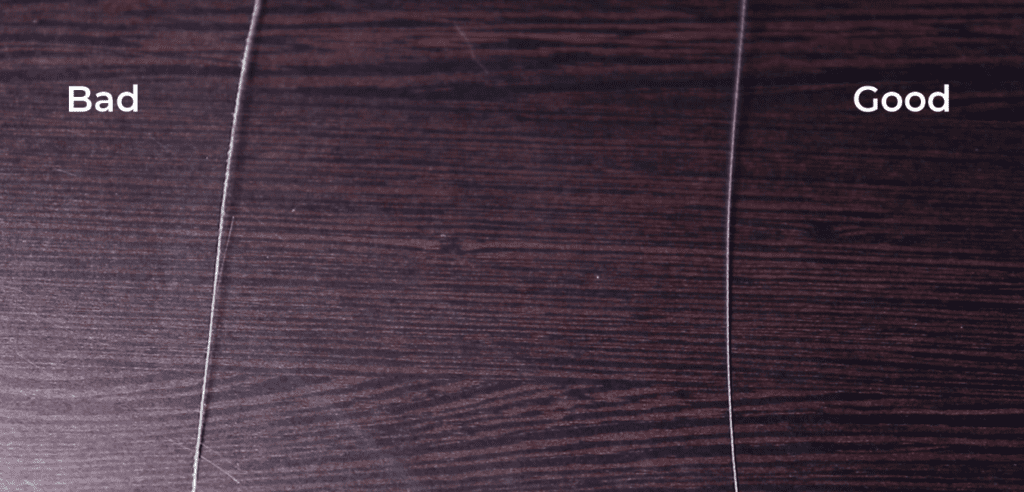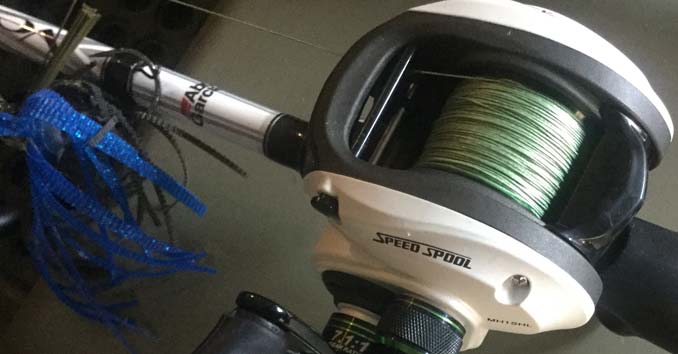Fishing with braided line has become increasingly popular in recent years, and for good reason. The thin, strong line allows for longer casts, better sensitivity, and improved hooksets. However, while braided line has its advantages, it is not always the best choice. In fact, there are certain situations where using braided line can actually hinder your fishing success. So, when should you not use braided line? In this article, we’ll explore the answer to that question and provide some helpful tips for choosing the right fishing line for your next outing.
One reason to avoid using braided line is if you’re fishing in clear, shallow water. The thin diameter of braided line can be a dead giveaway to wary fish, and it can also spook them if the line is visible in the water. Additionally, braided line has no stretch, which can be a disadvantage when fishing for species that are prone to spooking or that require a more subtle presentation. So, if you’re fishing in clear water, you may want to opt for a monofilament or fluorocarbon line instead. There are several other scenarios where braided line may not be the best choice, so let’s dive in and explore them further.
Braided line is not recommended for fishing in clear waters as it is highly visible to fish. It is also not suitable for fishing in heavy cover as the lack of stretch can cause the line to snap. Braided line can also damage fishing rod guides and should not be used on rods with delicate guides. Lastly, braided line is more expensive than other types of fishing lines, which may not be ideal for budget-conscious anglers.

When Should You Not Use Braided Line?
Braided lines are a popular choice among anglers because they offer superior strength, sensitivity, and casting distance. However, there are certain situations where braided lines may not be the best option. In this article, we will explore the scenarios where braided lines should be avoided.
1. Clear Water Fishing
In clear water, fish can be easily spooked by the sight of braided lines. The high visibility of braided lines can alert fish to the presence of the angler, making them less likely to bite. In such situations, it is better to opt for a fluorocarbon or monofilament line that is less visible in the water.
2. Fishing with Light Lures
Braided lines are thicker and heavier than other types of fishing lines. This makes them unsuitable for use with light lures or when fishing for species that are easily spooked. Light lures require a lighter line to ensure that they move freely in the water and mimic the movements of live bait. In such cases, it is better to use a monofilament or fluorocarbon line that is thinner and more flexible.
3. Fishing in Weedy Areas
Braided lines are not suitable for fishing in weedy areas. The lack of stretch in braided lines can make it difficult to detect bites when fishing in weed-infested waters. Additionally, the lack of stretch can make it challenging to free the hook from weeds and other underwater obstructions. In such situations, it is better to use a monofilament or fluorocarbon line that has more stretch and is better suited for fishing in weedy areas.
4. Fishing in Shallow Water
Braided lines have a high visibility and can spook fish when fishing in shallow water. Additionally, the lack of stretch in braided lines can make it challenging to control the movement of the bait or lure in shallow water. Monofilament or fluorocarbon lines are better-suited for fishing in shallow waters because they are thinner, more flexible, and less visible in the water.
5. Fishing for Trout
Trout are a species that can be easily spooked by the sight of braided lines. The high visibility of braided lines can alert trout to the presence of the angler, making them less likely to bite. In such situations, it is better to use a fluorocarbon or monofilament line that is less visible in the water.
6. Fishing in Heavy Currents
Fishing in heavy currents can be challenging, especially when using braided lines. The lack of stretch in braided lines can make it difficult to control the movement of the bait or lure in fast-moving waters. In such situations, it is better to use a monofilament or fluorocarbon line that has more stretch and is better suited for fishing in heavy currents.
7. Fishing with Topwater Lures
Braided lines are not suitable for use with topwater lures. The lack of stretch in braided lines can make it difficult to control the movement of the bait or lure in the water, resulting in a less natural presentation. In such situations, it is better to use a monofilament or fluorocarbon line that is more flexible and better suited for use with topwater lures.
8. Fishing in Cold Water
Braided lines are not suitable for fishing in cold water. The lack of stretch in braided lines can make it difficult to detect bites when fishing in cold water. Additionally, the lack of stretch can make it challenging to keep the hook in the fish’s mouth, resulting in more missed bites. In such situations, it is better to use a monofilament or fluorocarbon line that has more stretch and is better suited for fishing in cold water.
9. Fishing in Clear Skies
Fishing in clear skies can make braided lines more visible to fish, making them less likely to bite. Additionally, the high visibility of braided lines can alert fish to the presence of the angler, making them more cautious. In such situations, it is better to use a fluorocarbon or monofilament line that is less visible in the water.
10. Fishing with Ultra-Light Tackle
Braided lines are not suitable for use with ultra-light tackle. The lack of stretch in braided lines can make it difficult to detect bites when fishing with ultra-light tackle. Additionally, the lack of stretch can make it challenging to control the movement of the bait or lure, resulting in a less natural presentation. In such situations, it is better to use a monofilament or fluorocarbon line that is more flexible and better suited for use with ultra-light tackle.
In conclusion, while braided lines offer superior strength and sensitivity, they are not suitable for all fishing scenarios. Anglers should consider the fishing conditions and target species before deciding which line to use. In certain situations, monofilament or fluorocarbon lines are a better option for a successful fishing trip.
Frequently Asked Questions
When it comes to using braided line for fishing, there are certain situations where it may not be the best choice. Here are five common questions and answers about when you should avoid using braided line.
1. When should you not use braided line for fishing?
Braided line is not recommended for fishing in heavily vegetated areas, as it can easily get tangled and caught in the plants. This can be frustrating for the angler and can also harm the environment by damaging the vegetation. Braided line can also be difficult to use when fishing in clear water, as it is highly visible to fish and can spook them.
Additionally, braided line is not the best choice for fishing in very deep water, as it has a tendency to float and can make it difficult to maintain contact with the bait or lure. In these situations, a fluorocarbon or monofilament line may be a better choice.
2. Is braided line suitable for all types of fishing?
Braided line is a versatile fishing line that can be used for a variety of fishing styles, including spinning, baitcasting, and trolling. However, it may not be the best choice for all types of fishing. As mentioned earlier, it is not recommended for fishing in heavily vegetated areas, clear water, or very deep water.
Additionally, braided line may not be the best choice for finesse fishing, as it is thicker and less sensitive than fluorocarbon or monofilament lines. In finesse fishing, sensitivity is key, and a thinner, more sensitive line may be necessary to detect light bites and make accurate casts.
3. Can braided line damage fishing gear?
Braided line is a very strong and durable fishing line, but it can be abrasive and may cause damage to certain types of fishing gear. It is important to use a leader when using braided line, especially when fishing around rocks, logs, or other hard objects that could cause the line to fray or break.
In addition, braided line may cause damage to fishing rod guides if they are not designed to handle the abrasive qualities of the line. It is recommended to use guides that are specifically designed for braided line, or to use a monofilament or fluorocarbon leader to prevent damage to the guides.
4. Is braided line more expensive than other types of fishing line?
Braided line can be more expensive than other types of fishing line, but it is also more durable and long-lasting. While a spool of braided line may cost more initially, it can last longer than a spool of monofilament or fluorocarbon line, which may need to be replaced more frequently.
Additionally, braided line can offer better casting distance and accuracy, which can help anglers catch more fish and improve their overall fishing experience. In the long run, investing in a high-quality braided line can be a wise choice for serious anglers.
5. What are the benefits of using braided line for fishing?
There are several benefits to using braided line for fishing. First, it is very strong and durable, which means that it can handle heavy fish and tough fishing conditions. Second, it is highly sensitive, which allows anglers to feel even the slightest bites and make accurate casts.
Third, braided line has a smaller diameter than other types of fishing line, which allows for better casting distance and accuracy. Fourth, it has little to no stretch, which means that anglers can set the hook more quickly and keep constant pressure on the fish.

Top 3 Reasons YOU should Use BRAIDED LINE !
In summary, braided line is an excellent choice for various fishing situations. Its strength, sensitivity, and low stretch make it a favorite among anglers. However, there are specific scenarios where using braided line may not be the best option.
For example, if you are fishing in clear water or targeting finicky fish, braided line’s visibility may spook the fish, causing them to avoid your bait. Additionally, if you are fishing in heavy cover or around sharp rocks, braided line’s lack of stretch may result in more lost fish or broken lines. Therefore, it’s essential to consider the fishing conditions and the fish species you are targeting before deciding to use braided line.
Overall, as a professional writer, it’s crucial to highlight the pros and cons of different fishing techniques and equipment. By doing so, we can help anglers make informed decisions that will enhance their fishing experience and increase their chances of success. So, while braided line is a versatile and effective fishing line, it’s not always the best choice in every situation.
